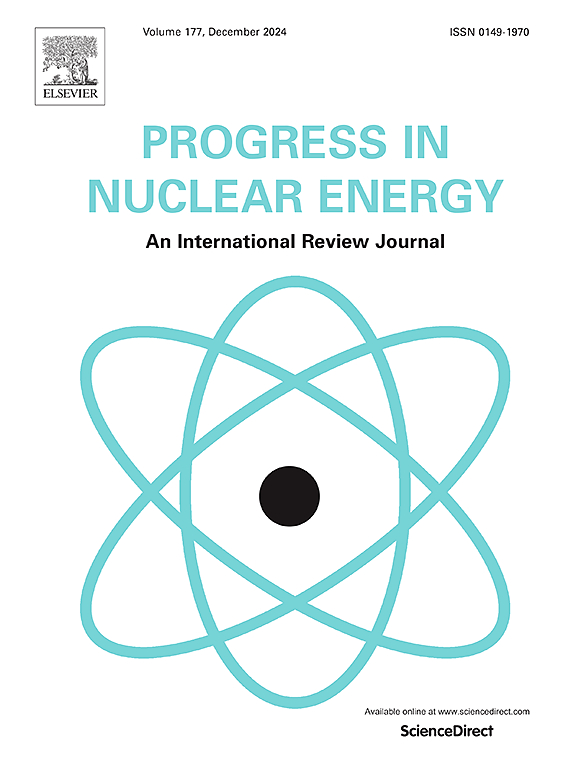AP1000核电厂非均质地形和密集建筑条件下gpu加速QES风洞模拟性能评价及灵敏度分析
IF 3.2
3区 工程技术
Q1 NUCLEAR SCIENCE & TECHNOLOGY
引用次数: 0
摘要
准确的空气弥散模型可以有效地支持核事故应急决策和应急规划区域优化,提高先进核电站的安全性和经济性。然而,快速和详细的空气分散建模仍然具有挑战性的异质地形和密集的建筑环境。本研究提出了gpu加速快速环境模拟(QES)系统,用于模拟非均匀地形和密集建筑物存在下的高分辨率风和浓度场,并通过AP1000站点的两个风洞实验对其进行了验证,评估了水平和垂直剖面的风向、速度和污染物浓度。对求解器选项、每秒释放粒子数、非局部混合系数和网格大小进行了敏感性分析。结果表明,GPU-QES成功地再现了建筑物之间的涡旋,并在4秒内模拟了3500万个网格的3km × 3km的详细风场。对于风场,超过50%的模拟在两个观测值的因子范围内。对于浓度场,在2 / 5因子范围内的模拟比例分别超过51%和85%,比可接受的下限高21%和15%,证实了QES在该核电站现场进行小规模模拟的能力。灵敏度分析表明,在类似的情况下,最优参数为全局记忆解算器,每秒释放粒子数为200,非局部混合系数为0.3 m2/s2,水平和垂直网格尺寸均为5 m。对于确定EPZ的重要站点边界,GPU-QES仅比测量值低49%,而直线高斯羽流模型高估了8.23倍,证明了GPU-QES在优化EPZ方面的潜力。本文章由计算机程序翻译,如有差异,请以英文原文为准。
Performance evaluation and sensitivity analysis of GPU-accelerated QES against wind tunnel experiments for air dispersion modeling under heterogeneous terrain and dense building at an AP1000 NPP site
Accurate air dispersion modeling can effectively support nuclear accident emergency decision-making and emergency planning zone (EPZ) optimization, for improved safety and economic efficiency of advanced nuclear power plants (NPPs). However, fast and detailed air dispersion modeling remains challenging for heterogeneous terrain and dense building environments. This study presents the GPU-accelerated Quick Environmental Simulation (QES) system for simulating high-resolution wind and concentration field in the presence of heterogeneous terrain and dense buildings, and validates it against two wind tunnel experiments of an AP1000 site, evaluating wind direction, speed, and pollutant concentration in both horizontal and vertical profiles. Sensitivity analyses were conducted on solver options, number of released particles per second, non-local mixing coefficients, and grid sizes. The findings demonstrate that GPU-QES successfully reproduces the vortices between buildings and takes only 4 s to simulate a detailed 3 km × 3 km wind field with 35 million grids. For wind fields, more than 50 % of the simulations were within a factor of two of the observations. For concentration fields, the fraction of simulations within a factor of two/five exceeds 51 % and 85 %, respectively, which are 21 % and 15 % higher than the acceptable lower limits, confirming QES's capability for small-scale modeling at this NPP site. Sensitivity analyses suggest the optimal parameters: global memory solver, released particles per second of 200, non-local mixing coefficients of 0.3 m2/s2, and grid size of 5 m both horizontally and vertically in similar scenarios. For the site boundary that is important in determining EPZ, the GPU-QES is only 49 % lower than the measurement, whereas the straight-line Gaussian plume model overestimates by 8.23 times, proving GPU-QES's potential in optimizing the EPZ.
求助全文
通过发布文献求助,成功后即可免费获取论文全文。
去求助
来源期刊

Progress in Nuclear Energy
工程技术-核科学技术
CiteScore
5.30
自引率
14.80%
发文量
331
审稿时长
3.5 months
期刊介绍:
Progress in Nuclear Energy is an international review journal covering all aspects of nuclear science and engineering. In keeping with the maturity of nuclear power, articles on safety, siting and environmental problems are encouraged, as are those associated with economics and fuel management. However, basic physics and engineering will remain an important aspect of the editorial policy. Articles published are either of a review nature or present new material in more depth. They are aimed at researchers and technically-oriented managers working in the nuclear energy field.
Please note the following:
1) PNE seeks high quality research papers which are medium to long in length. Short research papers should be submitted to the journal Annals in Nuclear Energy.
2) PNE reserves the right to reject papers which are based solely on routine application of computer codes used to produce reactor designs or explain existing reactor phenomena. Such papers, although worthy, are best left as laboratory reports whereas Progress in Nuclear Energy seeks papers of originality, which are archival in nature, in the fields of mathematical and experimental nuclear technology, including fission, fusion (blanket physics, radiation damage), safety, materials aspects, economics, etc.
3) Review papers, which may occasionally be invited, are particularly sought by the journal in these fields.
 求助内容:
求助内容: 应助结果提醒方式:
应助结果提醒方式:


